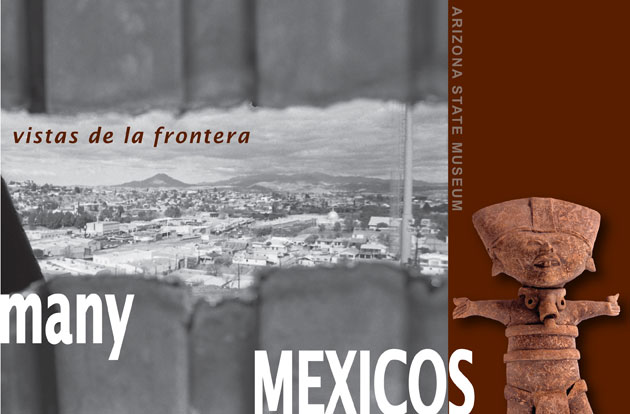 Many Mexicos: Vistas de la Frontera
Many Mexicos: Vistas de la Frontera
Opens November 19, 2010 at the Arizona
State Museum on the University of Arizona campus. Mon – Sat, 10 a.m. – 5
p.m. The exhibit will run for two years. An accompanying four-part
seminar series is scheduled for March 2011.
The exhibition opening November 19 at
Arizona State Museum strives to interpret the broad sweep of Mexican
history from the Pre-Columbian period to today’s political shouting
matches, all from the perspective of Arizona and the borderlands.
“So important right now, visitors will
make connections between the many histories of Mexico, seeing how our
own backyard reflects the Mexican historical experience,” said Dr.
Michael Brescia, exhibit curator. “In so many ways, the history of
Arizona reflects off the mirror of the Mexican past.”
Brescia is associate curator of
ethnohistory at Arizona State Museum, and associate professor of history
at the University of Arizona, and co-author of two timely and relevant
books on the history of Mexico.
Arizona’s borderlands -- that vast,
contested space -- was the outer rim of Mesoamerica in the Pre-Columbian
period and later evolved into the northern frontier of Spanish-Indian
relations following the conquest of Mexico. Moreover, the establishment
of the international border between the United States and Mexico in the
mid- nineteenth century set the tone for subsequent cross-cultural
contact and commercial exchange between individuals, local communities,
and nation-states that continue today despite the debates currently
raging over immigration. Indigenous and European, Asian and African,
newcomers and those here for a long time, all form part of the cultural
fabric that constitutes Mexico and, by extension, Arizona.
Brescia believes examining Mexico from the
perspective of Arizona and the borderlands is relevant to all of us
living in this state. “Now more than ever we can all benefit from a
little historical perspective to temper political passions and
illuminate the political and economic issues we face today with Mexico.”
Indeed those interested in better understanding the United States’
relationship with Mexico will gain much from walking through the many
Mexicos presented in this overview, from the complex societies of the
Mayas and Aztecs to the arrival of Spanish conquistadors and
missionaries to the drama of forging a nation-state during the 1800s in
the face of foreign invasions and civil discord to the revolutionary
call to arms from icons such as Pancho Villa and Emiliano Zapata.
Examples of the compelling objects and
artwork that illustrate the varied Mexican histories include a Maya
ritual corn vessel, Spanish colonial retablos, Santa Anna's sword and
uniform, Maximilian's ring and Carlota's broach, and a sombrero that may
well have belonged to Pancho Villa.
Community Group helps museum fill gaps
(University of Arizona, Tucson) Everyone
needs friends. You can never have too many. That’s especially true when
you’re an inadequately funded state institution. Arizona State Museum
(ASM) has recently formed a group called the Friends of the ASM
Collections. A sub-set of the museum’s general membership, folks who
join the Friends work together to promote and strengthen the museum’s
world-class collections. "The ethnological collections at ASM are
indeed world class," notes curator Diane Dittemore. "However, for as
long as I have been here we’ve been frustrated at our inability to
actively collect important historic and contemporary works because we do
not have a regular acquisitions budget. Friends of the ASM
Collections has opened up a whole new world for us." Continue reading...
 Arizona
State Museum, in partnership with other museums across the country, has
launched a study to find out what you expect and want from museums.
Your individual information will be kept confidential and will not be
shared or used for any solicitations. If you haven't already, please
take a moment to fill out this important survey at
Arizona
State Museum, in partnership with other museums across the country, has
launched a study to find out what you expect and want from museums.
Your individual information will be kept confidential and will not be
shared or used for any solicitations. If you haven't already, please
take a moment to fill out this important survey at  Many Mexicos: Vistas de la Frontera
Many Mexicos: Vistas de la Frontera